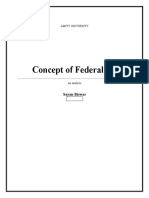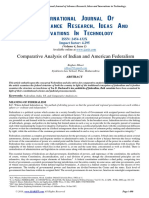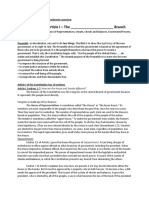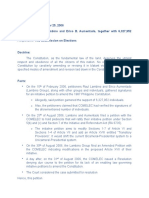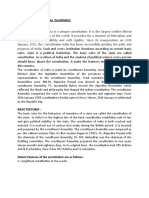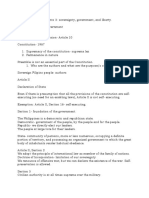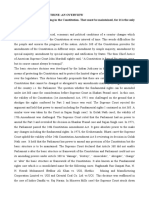Define federalism and explain the federal principles.
Federalism is a system where power is divided between a central authority and regional/state
governments, each with defined jurisdictions, ensuring a balance between national unity and
regional autonomy. Key principles include constitutionalism, separation of powers, and judicial
review. Here's a more detailed explanation: Definition: Federalism is a system of government
where power is divided between a central (or federal) authority and regional or state
governments, rather than being concentrated in one level. Key Principles: Constitutionalism: A
written constitution outlines the division of powers and responsibilities between the different
levels of government, ensuring that power is limited and accountable. Separation of Powers:
Each level of government (central and state) has its own distinct powers and responsibilities,
preventing any one level from becoming too powerful. Judicial Review: A court system, often
with a supreme court, has the authority to interpret the constitution and resolve disputes between
the different levels of government, ensuring that laws and actions are in accordance with the
constitution. Checks and Balances: Each level of government has the ability to check the powers
of the other levels, preventing any one level from becoming too dominant. Benefits of
Federalism: Protection of Individual Liberties: By dispersing power, federalism can help protect
individual liberties and local autonomy. Accommodation of Diversity: Federalism allows for
regional diversity and caters to the specific needs of different regions. Promotes Participation:
Multiple levels of government can lead to greater citizen participation in government.
Experimentation: Different states or regions can experiment with different policies and
approaches, allowing for a more adaptable and responsive government. Examples: The United
States, Canada, India, and Germany are examples of countries with federal systems of
government.
what are the essential characteristic of Federal constitution?
A federal constitution, crucial for dividing power and ensuring autonomy, typically features a
written constitution, a division of powers, a bicameral legislature, an independent judiciary, and
a rigid amendment process, all designed to protect against tyranny and promote stability. Here's a
more detailed explanation of these key characteristics: Written Constitution: A federal
constitution is typically written, establishing the framework for the government and outlining the
powers of the different levels of government. Division of Powers: Federal constitutions delineate
the powers of the central government and the constituent units (states or provinces), ensuring that
neither level becomes overly dominant. Bicameral Legislature: Many federal systems have a
bicameral legislature, with one house representing the population and the other representing the
states or regions, ensuring representation for all levels of government. Independent Judiciary: A
federal constitution often establishes an independent judiciary to interpret the constitution and
resolve disputes between different levels of government, ensuring that the constitution is upheld.
Rigid Amendment Process: Federal constitutions usually have a more difficult amendment
process than unitary constitutions, making it harder to change the fundamental principles of the
government and protect the rights of the states or regions. Dual Polity: Federalism involves a
dual government polity, where both the central and state/provincial governments have their own
jurisdictions and powers. Supremacy of the Constitution: The constitution is seen as the supreme
law of the land, and all actions of government must be in accordance with it.
distinguish between unitary and Federal constitution with example.
In a unitary system, power is concentrated in a central government, with subordinate regional
entities, while in a federal system, power is constitutionally divided between a central
government and regional governments, each with its own sphere of authority. Unitary System:
�Centralized Power: All governmental power is vested in the central government, with regional
units being subordinate and subject to its control. Example: The United Kingdom, where the
central government can make laws and policies that apply to the entire country, and regional
entities like Scotland or Wales have limited autonomy. Flexibility: The central government can
easily change the powers or structure of regional entities, as they are not constitutionally
protected. Single Constitution: There is typically a single constitution for the entire country, with
no separate constitutions for regional entities. Federal System: Divided Power: Power is
constitutionally divided between a central government and regional governments, each with its
own sphere of authority. Example: The United States, where there is a federal government
responsible for national issues, and individual states have their own governments with powers
over issues within their borders. Constitutional Protection: The powers of regional governments
are constitutionally protected, meaning the central government cannot unilaterally change them.
Multiple Constitutions: There can be multiple constitutions, with one for the federal government
and one for each state or province. Independent Judiciary: A federal system often includes an
independent judiciary that can interpret the constitution and resolve disputes between the federal
and state governments.
Briefly discuss the concept of cooperative federalism and the role of interstate Council.
Cooperative federalism involves collaboration between the central and state governments to
achieve common goals, while the Inter-State Council (ISC) under Article 263 of the Indian
Constitution facilitates this cooperation by providing a platform for dialogue, dispute resolution,
and policy coordination. Cooperative Federalism: Definition: Cooperative federalism signifies a
system where the central and state governments work together to address national challenges,
balancing national unity with regional diversity. Indian Context: While the Indian Constitution
doesn't explicitly use the term "cooperative federalism," the functioning of the constitution
implicitly promotes it, emphasizing collaboration and shared responsibility. Importance: It's
crucial for effective governance, ensuring that national and regional interests are aligned and that
policies are implemented effectively. Role of the Inter-State Council (ISC): Constitutional Basis:
The ISC is established under Article 263 of the Constitution to investigate and discuss matters of
common interest, and to make recommendations for better coordination of policy and action.
Functions: Facilitating Dialogue: The ISC provides a platform for discussions and negotiations
between the Centre and States, promoting understanding and cooperation. Conflict Resolution: It
investigates and advises on disputes that may arise between states or between states and the
center, acting as a mediator. Policy Coordination: The ISC discusses matters of common interest
and makes recommendations to ensure alignment in Union and State policies. Recommendation
Mechanism: The ISC makes recommendations for improving Centre-State cooperation.
Significance: The ISC plays a vital role in strengthening cooperative federalism by promoting
dialogue, resolving disputes, and facilitating policy coordination between the Centre and States.
What is the theory of territorial nexus in the legislative relationship between the Union and the
States?
The theory of territorial nexus, rooted in Article 245 of the Indian Constitution, dictates that state
legislatures generally have legislative power limited to their geographical boundaries, but can
enact laws with extra-territorial effect if a sufficient nexus (connection) exists between the state
and the subject matter. Here's a more detailed explanation: General Principle: Article 245
establishes that Parliament can make laws for the whole or any part of the territory of India,
while state legislatures can make laws for the whole or any part of their respective states.
Territorial Nexus: The doctrine of territorial nexus, also known as the doctrine of extra-territorial
�operation, is an exception to this general principle. Extra-Territorial Operation: It allows state
laws to apply to matters that occur outside the state's boundaries, provided there is a real and
substantial connection between the state and the subject matter of the legislation. Examples: This
principle is often used in cases of taxation, where a state can tax income or property that has a
sufficient connection to the state, even if it is earned or located outside the state's borders.
Distinction from Parliament: While the principle applies to state legislatures, Parliament has
inherent power to legislate for extra-territorial operations, meaning they can make laws that
apply outside India's borders. Key Considerations: The connection between the state and the
subject matter must be real and not illusory. The liability or effect of the law must be pertinent to
that connection. The doctrine ensures that state legislative power is not unduly restricted by
territorial boundaries and allows for practical governance of matters with a sufficient connection
to the state.
explain the concept of residuary power in under the Indian Constitution.
In the Indian Constitution, residuary powers, as enshrined in Article 248, vest in the Union
Parliament, granting it the authority to legislate on matters not specifically mentioned in the State
or Concurrent Lists, including imposing taxes not listed there. Here's a more detailed
explanation: What are Residuary Powers? These are powers that are not explicitly assigned to
any specific authority (state or federal) but are retained by the central government. In the Indian
context, the Union Parliament holds these residuary powers, meaning it can legislate on subjects
not listed in the Union, State, or Concurrent Lists. Constitutional Basis: Article 248 of the
Constitution explicitly grants the Parliament the power to make laws on any matter not included
in the State List or Concurrent List. This includes the power to impose taxes that are not
mentioned in either of those lists. Purpose of Residuary Powers: The concept of residuary
powers ensures the Union Parliament can address unforeseen matters or emerging issues that
might not be covered in the existing list of subjects. It provides a mechanism for the Union
government to legislate on matters of national importance that might arise after the constitution
was drafted. Example Subjects like computer software, e-commerce, etc., which came into being
after the constitution was created, fall under the residuary powers of the Union Parliament.
Borrowed from Canadian Constitution The concept of residuary powers in the Indian
Constitution is borrowed from the Canadian Constitution.
what is the role of finance commission in maintaining the financial balance between union and
state?
The Finance Commission, a constitutional body under Article 280, plays a crucial role in
maintaining financial balance between the Union and states by recommending the distribution of
tax revenues and providing grants-in-aid to states in need. Here's a more detailed explanation of
its role: Distribution of Tax Revenues: The commission recommends how the net proceeds of
taxes, which are to be divided between the Union and the States, should be distributed. It also
recommends how these proceeds should be allocated among the states themselves. Grants-in-
Aid: The Finance Commission determines the principles and quantum of grants-in-aid to states
that require financial assistance. Augmenting State Finances: The commission recommends
measures to augment the Consolidated Fund of a state to supplement the resources of the
Panchayats and Municipalities. Promoting Fiscal Federalism: By ensuring equitable distribution
of resources, the Finance Commission fosters a cooperative and balanced federal structure,
promoting fiscal autonomy and efficiency in both the Union and state governments. Advisory
Body: The Finance Commission is an advisory body, and its recommendations are not binding
on the government.
�what are the different types of federalism and how they function in different countries?
Federalism, a system where power is divided between a central government and regional/state
governments, can be broadly categorized into "coming together" and "holding together"
federations, with variations in how they function across countries like the US, India, and
Switzerland. Types of Federalism: Coming Together Federations: These arise when independent
states voluntarily unite to form a larger federation, like the United States and Switzerland.
Holding Together Federations: These emerge when a large, existing country decides to share
power between its central and regional governments, as seen in India and Spain. Functioning of
Federalism in Different Countries: United States: The US follows a "coming together" model,
where states have significant autonomy but are bound by a strong federal government with
powers over areas like defense and foreign policy. India: India is a "holding together" federation,
with a strong central government but also significant powers granted to the states, with a focus
on cooperative federalism where the center and states work together. Switzerland: Switzerland is
a "coming together" federation, known for its decentralized system with cantons having
considerable autonomy, while the federal government handles matters of national interest.
what is delegated legislation and how it is controlled by Judiciary and Parliament ?
Delegated legislation, also known as secondary or subordinate legislation, is law made by bodies
other than Parliament, to whom Parliament has delegated this power. It's controlled by both the
Parliament and the Judiciary through various mechanisms to ensure it doesn't exceed the scope of
the enabling Act. Parliamentary Control: Scrutiny Committees: Parliament uses committees to
scrutinize delegated legislation, ensuring it aligns with the parent Act and doesn't infringe on
fundamental rights. Parliamentary Debate: Delegated legislation can be debated in Parliament,
allowing for discussion and potential amendments or repeal. Negative and Affirmative
Resolutions: Parliament can use negative resolution procedures, allowing for the legislation to be
overturned if not approved by both houses, or affirmative resolution procedures, requiring
explicit approval. Power to Repeal or Amend: Parliament retains the power to repeal or amend
the enabling Act, thereby invalidating any delegated legislation based on it. Judicial Control:
Doctrine of Ultra Vires: The courts can declare delegated legislation invalid if it goes beyond the
powers granted by the parent Act (substantial ultra vires) or if it violates procedural requirements
(procedural ultra vires). Judicial Review: Courts can review delegated legislation to ensure it is
reasonable, fair, and not arbitrary or discriminatory. Enforcement of Fundamental Rights: The
judiciary can strike down delegated legislation if it infringes upon fundamental rights guaranteed
by the Constitution.
Explain the administrative relationship between the Union and the States. How does the Union
exercise control over State governments?
The Indian Constitution outlines administrative relations between the Union and States in
Articles 256-263, emphasizing cooperation and coordination. While states have autonomy, the
Union exercises control through directions, delegation of functions, and mechanisms like the
Inter-State Council. Here's a more detailed explanation: Constitutional Framework: Part XI of
the Indian Constitution (Articles 256-263) deals with the administrative relations between the
Union and the States. These articles aim to ensure smooth functioning and cooperation between
the two levels of government. The Constitution divides powers between the Union and the
States, with the Union having a superior role in administrative matters. Union's Control
Mechanisms: Directions to States: The Union can issue directions to States to ensure compliance
with laws made by Parliament or any existing laws. Delegation of Functions: The Union can
entrust certain functions to the States with the consent of the State government. All-India
�Services: The Union government can deploy All-India Service officers to states, which helps in
maintaining uniformity and coordination. Inter-State Council: This council, established under
Article 263, advises on matters of common interest and helps in resolving disputes between the
Union and States or among States. Financial Control: The Union government can provide
financial assistance to states, but these grants are often subject to certain conditions, giving the
Union leverage. President's Rule: In extreme cases, where a state government cannot be carried
on according to the Constitution, the President can impose President's Rule, taking over the
functions of the state government. Cooperation and Coordination: The Constitution also
promotes cooperation and coordination between the Union and the States through various
mechanisms. Mutual Delegation of Functions: The Union and States can exchange
administrative functions with the consent of the other party. Parliamentary Control: Parliament
can legislate on matters in the State List in certain circumstances, giving the Union a degree of
control. Key Articles: Article 256: Emphasizes that the executive power of the State must be
exercised so as to ensure compliance with laws made by Parliament. Article 257: Allows the
Union to issue directions to States on matters of national importance, such as communication and
railway protection. Article 258: Enables the Union to entrust functions to State governments and
vice-versa. Article 262: Provides for Parliamentary control over inter-state rivers and the
adjudication of inter-state water disputes. Article 263: Establishes the Inter-State Council.







































